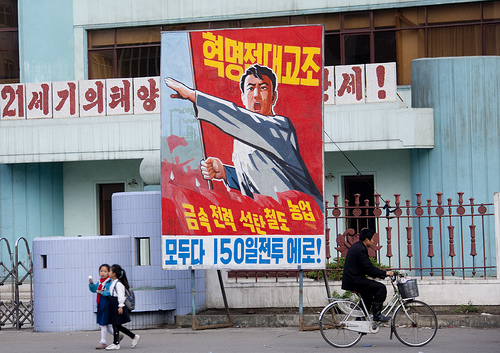According to the Daily NK:
An oft-cited example of an advocate of reform within the North Korean leadership, former Prime Minister Park Bong Ju [aka Pak Pong-ju] appeared alongside Kim Jong Il during a recent onsite inspection at a Pyongyang sock factory, leading to suggestions that North Korea may again be contemplating the idea of embracing economic reform.
However, this is less likely than another explanation; that Park was brought back into the fold to oversee a number of revisions to the legal code during 2010.
Park, whose appearance at the onsite inspection was verified in five images broadcast by Chosun Central Television on the 11th, was a leading architect of the July 1st Economic Management Reform Measure of 2002, which formalized a number of relatively liberal economic policies.
He then became Prime Minister in September 2003, but was deposed during a period of economic retrenchment in April 2007, sent into virtual exile in South Pyongan Province as manager of Suncheon Vinalon Complex.
As a result of this career path, Park is seen by many as a reformist thinker in the North Korean elite.
Therefore, when he stepped back onto the main political stage this August, three years and four months later, mentioned in a report published by Chosun Central News Agency on August 21st about the 50th anniversary of a well-known Pyongyang restaurant, Okryugwan, it led to suggestions that North Korea might be set to head down the road to economic reform, led by Park as Party First Vice Director.
However, Park’s re-emergence does not mean that North Korea is about to turn towards market mechanisms on an official basis; conversely, it is more likely to be related to the revision this year of a number of laws which were actually designed to strengthen the control and supervisory functions of state institutions.
North Korea officially revised the People’s Economic Planning Law on April 6th alongside the Pyongyang Management Law, revised on March 30th, and both its Labor Protection and Chamber of Commerce and Industry Laws, revised on July 8th.
In revealing the legal revisions to The Daily NK in an interview in November, an inside North Korean source commented on the intention behind the changes, saying, “The People’s Economic Planning Law of 2001 alleviated national controls and supervision, even though it came before the July 1st measure of 2002. However, the revised bill strengthens national controls.”
Additionally, the source went on, “This series of bills including the revised People’s Economic Planning Law are the basis of the nation’s control, management and supervision. It should be understood as being part of the same flow as the series of measures undertaken during the succession process since October of 2007, when market controls began wholeheartedly; the 150-day Battle, 100-day Battle and currency redenomination.”
Accordingly, research suggests that North Korea probably chose to play the Park Bong Ju card now to revise state policy to try and sort out the problems left behind by the failure of the 2009 currency redenomination and to address the pressing need to improve the state of the domestic economy, whilst also hoping that the appointment of an official with a reformist image might attract investment from Northeast China and further afield.
Michael Madden has written a bio of Pak Pong-ju. Read it here.
Read the full Daily NK sotry below:
Park’s Appearance Unlikely to Mean Real Reform
Daily NK
Kim So-yeol
12/13/2010

